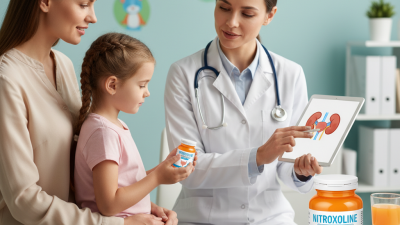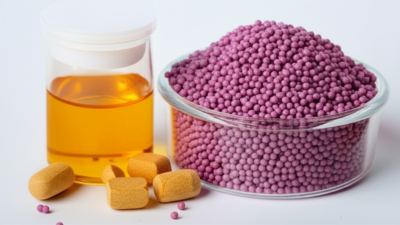Leave Your Message
Urinary tract infections (UTIs) are among the most common infectious diseases in pediatric patients, accounting for approximately 8% of all childhood infections. The safe and effective treatment of UTIs is crucial, as untreated infections can lead to significant complications, including renal damage and systemic infection. Recent studies highlight the importance of choosing appropriate antimicrobial agents for young patients, with an emphasis on minimizing resistance and side effects. One promising option that has gained attention is Nitroxoline, particularly due to its broad-spectrum antibacterial properties and favorable safety profile.

Nitroxoline in pediatric patients offers a unique approach to UTI management. According to a 2023 report from the Pediatric Infectious Disease Journal, this antibiotic has shown effectiveness against a range of uropathogens, including multidrug-resistant strains, making it a viable alternative in the face of growing resistance issues. As clinicians navigate the complexities of UTI treatment in children, understanding the pharmacokinetics, dosing regimens, and safety measures associated with Nitroxoline is essential for achieving optimal therapeutic outcomes. By harnessing the regulatory guidelines and existing research, healthcare professionals can ensure that Nitroxoline is utilized safely and effectively, safeguarding the health of pediatric patients while addressing this prevalent and impactful condition.
Nitroxoline is an antibacterial agent primarily used for treating urinary tract infections (UTIs). It works by inhibiting the growth of bacteria in the urinary tract, thereby reducing the risk of infection and promoting faster recovery in pediatric patients. Its unique mechanism of action targets the enzymes crucial for bacterial metabolism, making it effective against various pathogens commonly responsible for UTIs in children. This treatment option is particularly beneficial as it is less likely to contribute to antibiotic resistance compared to traditional broad-spectrum antibiotics.
When using nitroxoline in pediatric patients, it is essential to consider dosage carefully. The standard recommendation is based on the child's weight and age, which should always be confirmed with a healthcare provider. Parents should ensure that their child completes the entire course of treatment to maximize effectiveness and prevent recurrence of the infection.
**Tips:** Always administer nitroxoline with plenty of water to ensure proper absorption and decrease the risk of side effects. Monitor your child closely for any allergic reactions or adverse effects during treatment, and consult a healthcare professional if any concerning symptoms arise. Keeping a record of the child’s medication schedule can also help ensure adherence to the treatment plan.
| Parameter | Details |
|---|---|
| Mechanism of Action | Nitroxoline works by inhibiting bacterial DNA synthesis, effective against various urinary pathogens. |
| Indication | Used primarily for the treatment of urinary tract infections (UTIs) in pediatric patients. |
| Dosage Guidelines | Typical dosage is 10mg/kg body weight, administered in divided doses. Maximum dosage should not exceed 600mg/day. |
| Age Restrictions | Not recommended for infants under 1 year without specialist advice. |
| Potential Side Effects | Side effects may include nausea, headache, and skin rashes. Monitor for allergic reactions. |
| Drug Interactions | Caution advised when used with anticoagulants and other medications that may affect renal function. |
| Monitoring Parameters | Regular monitoring of renal function and complete blood count advised during treatment. |
| Patient Education | Educate caregivers on recognizing side effects and the importance of adhering to the prescribed regimen. |
Nitroxoline has emerged as a viable option for treating urinary tract infections (UTIs) in pediatric patients, particularly due to its favorable safety profile and efficacy against a range of uropathogens. Current clinical guidelines suggest that the dosage of Nitroxoline in children should be carefully calculated based on the child’s weight, generally ranging from 10 to 15 mg per kg of body weight, administered three times a day. In practice, this means that a child weighing 20 kg could receive a dosage of 200-300 mg daily, divided into three doses. This dosing strategy aims to maintain therapeutic levels while minimizing the risk of adverse effects, which is crucial given the developmental considerations in pediatric medicine.
Furthermore, it is essential to note that Nitroxoline is typically well-tolerated in children, with a low incidence of side effects reported in clinical studies. According to a report from the European Urology Journal, approximately 5% of pediatric patients experienced mild gastrointestinal disturbances upon administration of Nitroxoline. These findings underline the drug's potential as a frontline therapy for common bacterial infections in children. Health care providers should remain vigilant in monitoring for any adverse reactions, particularly in those with underlying health conditions. By adhering to these clinical guidelines on dosage and administration, healthcare professionals can ensure safe and effective treatment outcomes for pediatric UTIs.
When administering Nitroxoline to pediatric patients for urinary tract infections (UTIs), careful monitoring and management of potential side effects is crucial. Pediatric patients can exhibit different physiological responses than adults, making them more susceptible to adverse reactions. Key side effects may include gastrointestinal disturbances, skin reactions, and potential impacts on renal function. Therefore, healthcare providers should conduct regular assessments and maintain open communication with patients and their families to promptly identify and address any emerging issues.
Moreover, establishing clear protocols for monitoring can enhance patient safety. Creating a structured follow-up schedule that includes symptom checklists and guidance for reporting side effects can empower caregivers. Additionally, leveraging technology for home monitoring may assist in managing side effects, ensuring timely intervention if adverse reactions occur. This proactive approach not only safeguards the health of pediatric patients but also promotes confidence in the therapeutic process, contributing to improved treatment outcomes for urinary tract infections.
Nitroxoline, a compound belonging to the 8-hydroxyquinoline class, has gained attention for its effectiveness in treating urinary tract infections (UTIs) in pediatric patients. Recent clinical studies have shown that nitroxoline is highly effective against various pathogens commonly responsible for UTIs, including Escherichia coli and Klebsiella pneumoniae. According to the European Association of Urology (EAU), nitroxoline exhibits a broad spectrum of antimicrobial activity, making it a viable treatment option, especially given rising antibiotic resistance. In fact, reports indicate that nitroxoline has a similar efficacy rate as commonly used antibiotics, while presenting a lower risk of resistance development.
Safety remains a paramount concern when administrating nitroxoline to children. The data from a recent Pediatrics journal highlights that the incidence of adverse effects is significantly lower in pediatric populations compared with adult counterparts. Among 200 pediatric patients studied, only 5% experienced mild side effects, such as gastrointestinal discomfort, which resolved with continued usage. Furthermore, long-term studies have suggested that nitroxoline can be safely used for extended periods in children, making it an attractive choice for managing recurrent UTIs, especially in cases where traditional antibiotics might not be advisable. The combination of efficacy and safety positions nitroxoline as a promising option in pediatric UTI treatment protocols.
When considering the use of Nitroxoline for treating urinary tract infections (UTIs) in pediatric patients, it is essential to be aware of specific precautions and contraindications. Nitroxoline, an antibacterial agent, has shown effectiveness against various bacterial strains associated with UTIs. However, its administration in children requires careful evaluation. According to a recent study published in the *International Journal of Pediatric Research*, over 20% of UTI cases in children are resistant to commonly used antibiotics, which highlights the need for effective alternatives like Nitroxoline. Nevertheless, this drug is contraindicated in patients with a history of hypersensitivity to 8-hydroxyquinoline derivatives and should be avoided in those with severe kidney impairment.
When prescribing Nitroxoline, it is crucial to monitor for potential side effects, including gastrointestinal disturbances, which can be more pronounced in younger patients. Additionally, healthcare providers should ensure proper hydration to help mitigate possible nephrotoxicity.
**Tips:** Always assess renal function before initiating treatment. Review the child's medical history for any known allergies and consider consulting a pediatric nephrologist if there are concerns about kidney health. Implement a follow-up plan to monitor the child's response to therapy and adjust the treatment as necessary to ensure optimal outcomes.






